-

人教版高中英语必修2The Olympic Games说课稿2篇
Purpose of my design:To ask the students to do these two tasks will make the Ss predict the story of this passage. As a result, it will deepen Ss’ memory of this story because they will have their own understanding of this story.Step 3. While-readingTask 1. (Individual work _____min)Skimming: ask students to skim the text and the main ideas of each paragraph in this passage. Please read it quickly and then match the sentences with the letters.Task 2. (Individual work _____min)Scanning: read the text quickly and decide the whether the following statements are true or false and give reasons.Task 3. (Pair work _____min)Listen to the tape and fill in the banks. Then read the paragraph with expression to your partner.Task4 (individual work min)Listen to the tape again and write down the main idea in one sentence.Purpose of my design: Enable students to understand the given material better by using different reading skills. And proper competition can arouse the Ss’ interest in English learning. “Task-based” teaching method is used here todevelop the Ss’ ability of communication and also their ability of co-operation will be well trainedStep 4. Post-readingTask 1. (Individual work, pair work, group work, class work; _____min)Discussion (group of 4):1. If you were Hippomenes, would you run against Atlanta?2. Do you think Hippomenes deserved to win the race? Why or why not?Step 5. HomeworkPlease read the story again carefully after class and imagine: What will happen during the race between Hippomenes and Atlanta? Who do you think will win the race? Do you think Atlanta would marry Hippomenes? Write an end for the story with thses questions.Purpose of my design: Homework is so important and necessary for to master the knowledge they learned after class. It will check whether the Ss achieve the teaching aims.Part 5 Blackboard design

人教版高中英语必修4A taste of English Humor说课稿3篇
Then I would ask them to think of a funny English or Chinese and tell it to partners. While telling stories, they can use expressions and some acting to help make the story funny. 5 minutes would be given to do this.Those stories they told there will be the material for their writing. Soletting them tell it at first is helpful. And they can make a difference between telling a funny story and writing it down. Generally speaking, it is difficult forstudents to write well because they don’t know what to write and how to write. Asking them to tell their own stories at first can help them come up with what to write.After their telling, I would invite someone to share his/her story with all of us and I would write it down on the blackboard.This example story would be used as a sample to illustrate the format of funny story. Different from a story from teacher or textbook, a story from students can obviously become a interesting material to draw students’ attention.Then I would ask the whole class to put this story into several parts. It might be a little bit difficult for them. So I would ask them to find out whether all the sentences are necessary. After delete some sentences, there are 6 sentences left behind. Then they can easily put them into three parts. After interaction with students, I would teach them the right terms for each part and conclude the format of funny story.This step is the key and difficult point in my lesson. So I mainly usetask-based teaching method in this part and the task for students was divided into several stages. With the separated difficult level, students can find there are usually three parts in writing. They can also learn to write without the unnecessary parts in the process of analyzing. And then I wouldn’t rush to tell them the right terms to them directly. Instead, I would ask them to name them by their own. A confused mind is better for acquiring knowledge.While-writing:Then I would give students 7 minutes to write down this story, without other requirements.With all the preparations in pre-writing, students’ difficulties were cleared. So it would be much easier for them to write down the story within 7 minutes. There are no other requirements because students’ first writing is actually a drafting. It would be revise and edit several times later. Writing, as a skill

人教版高中英语必修4Theme parks说课稿3篇
The oldest and the most popular park in the worldenjoy the exciting activities thereget close to the life-size cartoon characters like Mickey Mouse and Donald Duck Step 3 Pre-reading1.What do you suppose a theme park is ?2.What do you think you can see in a theme park?(1.It is a kind of amusement park which has a certain theme – that the whole park is based on. 2.buildings, castles, statues, rare animals and birds, and so on.) Step 4 Reading ----- Theme Parks –---- Fun and More Than Fun1.Predict : Read the title and the pictures on P. 34 and PredictWhat is the meaning of the title “Theme Park – Fun and more than fun”?(The title means that theme parks are fun to visit, but that they can also be educational and can offer useful information.)2.Skimming Fast read and answer:What activities can we take in a theme park?Amusement park: Bumper car Merry-go-round slide bungee jumping Free-fall rides Horror films Pirate ship Ferris wheel roller coaster3.Scanning Read again and you will find various theme parks are mentioned in the passage . Then what are they ?Theme parks: Sports theme park History theme park Culture theme park Marine or Ocean theme Park Future park Science theme park Disneyland4.Careful reading and find the main idea of each paragraph:THEME PARKS---- entertaining/ educationalPara.1 Traditional parks are places to go for relaxation and to have time away from our busy lives.Para.2 Theme parks are different They’re large and full of things to do, see and buy.Para.3 Theme parks are built around a single idea or theme. One example is a sports park.Para.4 Another kind of theme park is historical more and cultural and can be educational.Para.5 Disneylandwas the first theme park. It is based on the fantasy life and characters of Disney’s films.Para.6 Some examples of educational theme parks include sea world parks and science parks.

人教版高中英语必修3Healthy Eating说课稿4篇
Language learning needs a context, which can help the learners to understand the language and then can product comprehensible output, so computer has the advantages to make the materials attractive.Part 3 Learning MethodsTask-based, self-dependent and cooperative learningPart 4 Teaching ProcedureStep One Lead-in“Interest is the best teacher.” Therefore, at the very beginning of the class, I should spark the students’ mind to focus on the centre topic “the band”. I’ll show some pictures of food to attract their attention and then bring some questions.Question:What kind of food they like?What should go into a good meal?The answers must relate to the diet. After this, the students will be eager to know something about a balance diet and this is the very time to naturally lead the class into Step 2Step 2 Reading for information: skimming and scanning In this step, I use Task-based Language Teaching method, which can give students a clear and specific purpose while skimming and scanning the context.Task 1 General ideaThe students will be asked to just glance at the title and the pictures of the passage, and then guess what they will read in the text. And they’ll be divided into groups of four to have a discussion.The purpose is to inspire the students to read actively, not passively. In addition, the task is to develop the students’ reading skill by making prediction and to encourage the students to express their thoughts in English and cooperate with each other.Task 2 Main idea of each paragraphCooperative learning can raise the students’ interest and create an atmosphere of achievement. Based on this theory, I divide the whole class into 4 groups to skim the whole text and get the main idea of each paragraph.

人教版高中英语必修5First aid说课稿6篇
In this class, I have 3 teaching aims, that is, knowledge aims, ability aims and emotion aims.1) Knowledge-Teach students new words and expressions, such as temporary, bleed,sprain choke, first aid, fall ill and so on.-Enable students to have a better understanding for some basic knowledge of first aid.2) Ability-Train students’ speaking, reading and writing abilities by different teaching activities, such as skimming, comprehending, team work, role play, retelling and writing.-Develop students’ reading strategy on how to move general idea to specific information.3) Emotion-Promote students’ awareness of giving first aid.- Cultivate students’ creativities.Then let’s come to my teaching methods and activities.III. Teaching methods and activities:To achieve different teaching aims, various kinds of teaching methods and activities will be adopted throughout this period, such as TBL (task-based learning), skimming, team work, brainstorm and others, which can offer students opportunities to fulfill tasks in which they can use language to achieve a specific outcome.IV. Teaching aids:Computer and blackboardV. Teaching important points:1) Make students have a clear mind for the structure of the text.2) Help students understand the theme of the text.VI. Teaching difficulties:1) So many new words may affect students’ understanding.2) How to get students to know about the functions of the skin and thecauses, characteristics and treatments for different degree burns,and the knowledge about giving first aid. VII. Blackboard design:

人教版高中英语必修5The United Kingdom说课稿4篇
Teaching Aims:Knowledge 1. Get the students to learn the useful new words and expressions in this section. Aims:2. Let the students learn about how the UK was formed and the four groups of invaders.1. Develop students’ reading ability and let them learn different Ability reading skills. Aims:2. Enable students to learn to talk about the United Kingdom and the Union Jack Emotional 1. Let students know more about the UK2. Develop students’ sense of cooperative learning Aims:Teaching Important Points:1. Let the students learn about the countries of the United Kingdom and the Union Jack2. Get the students to read the passage and know about how the UK was formed and the four groups of invaders.3. Have the students learn different reading skills.Teaching Difficult Ponts:1. Develop students’ reading ability.2. Enable students to talk about the United Kingdom and the Union Jack.3. Let students learn how the UK was formed geographically and historically.Teaching Methods:Showing pictures, asking, exercising, listening, reading etc.Teaching Aids:A computer,a projector and a blackboard.Teaching Procedures: 1) Show a map of the world, ask students the following questions:Where is the UK?What’s the full name of the UK?2) Ask the students work in pairs to do the quiz on Page 9.Do you want to test how many things you know about the United Kingdom? Let’s have a small test.Using the map on P9, students answer the following questions:?How many countries does the UK consist of? What are they??England is divided into three main areas. Do you know what they are? 1) Scanning (10Minutes )Let the students hold the questions asked in pre-reading and read the passagequickly and then let them do the following exercise.Join lines to the right answer.
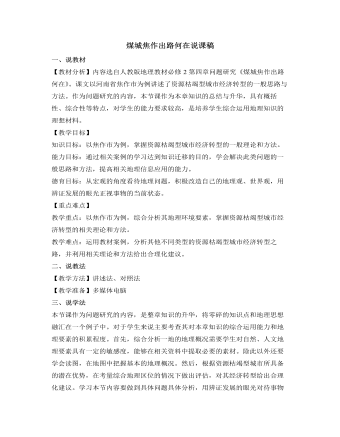
人教版高中地理必修2煤城焦作出路何在说课稿
分析过焦作市的地理概况和产业优势后,就需要针对由于资源枯竭所带来的问题提出合理化的建议。既然是谈经济转型,就应该将话题的范围明确在这一领域内。通过材料3的相关内容,我们了解到焦作市需要在产业结构调整、培育新的优势产业、增强综合竞争力等三个整改方针上下功夫。因而引导学生针对优势与不足提出建议,以三个整改方针为基准,衡量建议的可行性是锻炼学生解决此类问题的有效途径。在此我将教会学生的是解决问题方法而非案例的内容,正所谓“授之以鱼,不如授之以渔”。接下来针对学生的建议和教材资料分析所罗列的10点整改思路,由学生自由发言提出看法,通过教师的指导和学生的讨论,进而确定经济转型建议的具体方案。最后注意将建议与产业优势相对照,看建议是否都是围绕着产业优势而提出的,这样做会加深学生的印象,通过建议和优势的对应关系,将不难找出此类问题的解题思路。
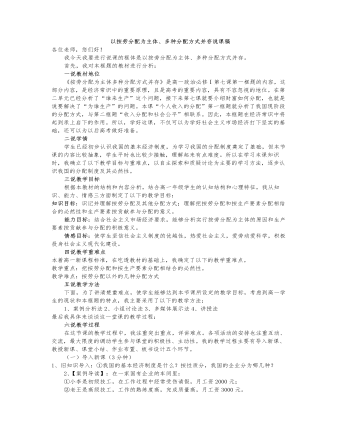
人教版高中政治必修1按劳分配为主体-多种分配方式并存说课稿
4、课堂讨论:社会主义的根本原则是共同富裕,这也是正确处理分配关系的目标。而十五大报告却进一步明确指出“允许和鼓励一部分人通过诚实劳动和合法经营先富起来,允许和鼓励资本、技术等生产要素参与收益分配”。这矛盾吗?为什么?以小组方式进行讨论,再以代表的形式发表意见,这样既调动了学生的积极性,也使学生对内容有了更深层次的了解。最后老师加以总结,用“蛋糕效应”来阐述“效率优先,兼顾公平”的关系,既形象又贴切,加深学生的理解。本课时内容比较抽象,学生对于概念的理解有较大的难度。因此在教学中我采用多媒体课件教学,联系生活实际,让学生在生活中去体会货币的职责,区分货币的职能,以便达到学以致用的目的。同时适时设置疑问,让学生与我共同思考,真正实现“师生互动,生生互动”,调动学生积极,主动的参与到教学实践活动中。(三)课堂小结,强化认识。(2—3分钟)通过归纳小结,既强调了重点,又巩固了本节知识,帮助学生形成知识网络,便于课后理解记忆。
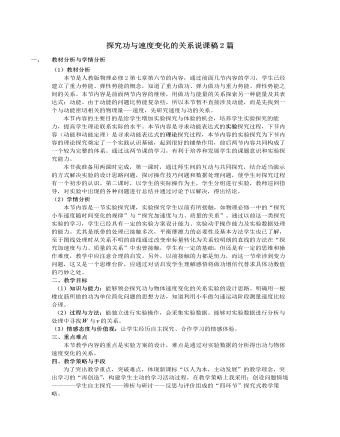
人教版新课标高中物理必修2探究功与速度变化的关系说课稿2篇
共享实验收集的信息,分享实验探究的结论,体验收获的乐趣。 小结拓展 这节课由大家感兴趣的球类运动和弹弓游戏,提出了功与速度变化关系的问题,利用倍增思想解决测量对物体做功的问题,使用我们熟悉的器材设计了探究方案,并进行实验探究,采用图像法进行数据处理,初步得出W∝V2的关系。在我们这节课探究以前,科学家就通过试验和理论的方法,已经总结出了功与速度变化的定量关系。人类社会也在社会生活和生产的各个领域予以利用。比如,古代的战争武器抛石器、大型弓弩,以及现代飞机弹射系统、还有机器人行走等等,希望同学在今后的学习中注意留心生活中的物理和社会中的物理。 领会总结。培养概括总结的能力,进一步巩固、感悟、提升实验探究中获得的思维能力及动手能力。感悟社会中的物理,认识物理学对科技进步以及文化和社会发展的影响。 列举学生知道的社会中做功使物体速度变化的例子,增强学生将物理知识应用于生活和生产的意识,培养学生的社会参与意识和对社会负责任的态度。
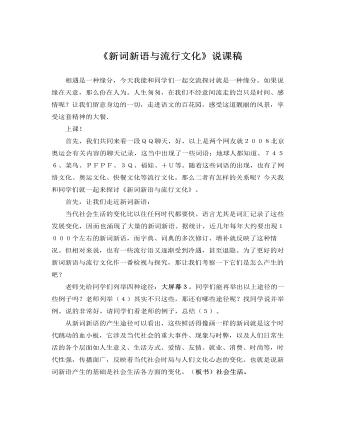
人教版高中语文必修1《新词新语与流行文化》说课稿
当代社会生活的变化比以往任何时代都要快。语言尤其是词汇记录了这些发展变化,因而也涌现了大量的新词新语。据统计,近几年每年大约要出现1000个左右的新词新语,而字典、词典的多次修订、增补就反映了这种情况。但相对来说,也有一些流行语又逐渐受到冷遇,甚至退隐。为了更好的对新词新语与流行文化作一番检视与探究,那让我们考察一下它们是怎么产生的吧?老师先给同学们列举四种途径:大屏幕3。同学们能再举出以上途径的一些例子吗?老师列举(4)其实不只这些,那还有哪些途径呢?找同学说并举例。说的非常好,请同学们看老师的例子,总结(5)。从新词新语的产生途径可以看出,这些鲜活得像画一样的新词就是这个时代跳动的血小板,它涉及当代社会的重大事件、现象与时弊,以及人们日常生活的各个层面如人生意义、生活方式、爱情、友情、就业、消费、时尚等,时代性强,传播面广,反映着当代社会时局与人们文化心态的变化。

人教版高中历史必修1世界多极化趋势的出现说课稿2篇
(一)本课教材地位分析本课教材的主题是世界格局多极化趋势的出现,在整个单元中有承前启后的作用,前一课是它的大背景,后一课是它的延续。本课的核心问题是两极格局下,20世纪六七十年代世界多极化趋势的出现。通过走向联合的欧洲、迅速崛起的日本、发展中国家的星期以及中国的崛起三方面内容,反映了世界格局多极化趋势的出现。在教学中,应注意利用学生对时事的关心与熟悉,引导学生进行相应的探究活动,使学生对世界格局的发展变化能够认识准确和完整把握。(二)三维目标A.知识与能力1.通过对欧洲一体化的进程、日本经济迅速崛起、不结盟运动和中国振兴的基本史实的学习,掌握20世纪六七十年代世界多极化趋势出现的史实,理解其世界大背景和“多极化”的概念。2.通过西欧、日本、中国的崛起,理解经济决定政治,政治反作用于经济。
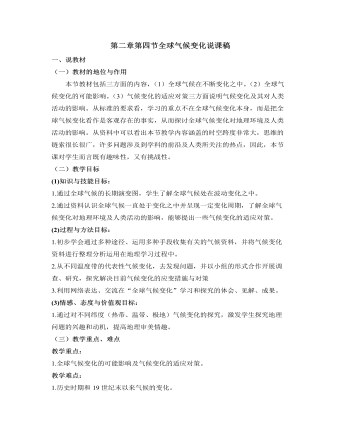
人教版高中地理必修1第二章第四节全球气候变化说课稿
(一)教材的地位与作用本节教材包括三方面的内容,(1)全球气候在不断变化之中。(2)全球气候变化的可能影响。(3)气候变化的适应对策三方面说明气候变化及其对人类活动的影响。从标准的要求看,学习的重点不在全球气候变化本身,而是把全球气候变化看作是客观存在的事实,从而探讨全球气候变化对地理环境及人类活动的影响。从资料中可以看出本节教学内容涵盖的时空跨度非常大,思维的链索很长很广,许多问题涉及到学科的前沿及人类所关注的热点,因此,本节课对学生而言既有趣味性,又有挑战性。 (二)教学目标(1)知识与技能目标:1.通过全球气候的长期演变图,学生了解全球气候处在波动变化之中。2.通过资料认识全球气候一直处于变化之中并呈现一定变化周期,了解全球气候变化对地理环境及人类活动的影响,能够提出一些气候变化的适应对策。
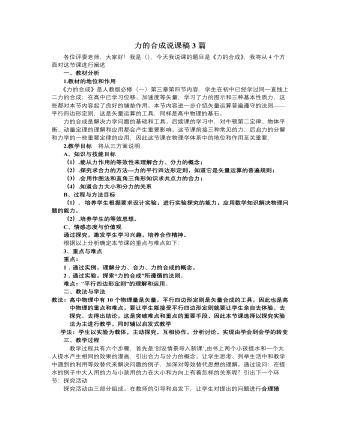
人教版新课标高中物理必修1力的合成说课稿3篇
① 实验设计将学生分组,利用桌上的器材进行探究(幻灯片展示)这个实验难度较大,为了降低难度,为实验探究铺下第二台阶,要求学生先分小组讨论以下问题(幻灯片展示)有些学生可能不知如何下手,我会要求学生先阅读课本中的实验描述从中得到一点提示,再让一两个小组同学回答,这样既体现了学生学习的主体性又可提高学生自主思考和语言表达能力,之后我再进行补充完善(幻灯片展示答案),并用幻灯片把实验步骤展示出来,在学生实验过程一直保留,使学生能朝正确的方向进行猜想和操作,为实验探究铺下第三个台阶。② 实施探究在学生分组进行探究过程,教师巡视解惑,随时观察学生情况,解答学生提出的问题,还可用自言自语方式提示应注意的一些问题,如仪器的正确使用,操作的规范等,帮助学生尽量在规定时间内顺利完成实验。

人教版新课标高中物理必修1牛顿第三定律说课稿2篇
问:为什么会出现这样的情况,男女生之间的拉力存在着怎样的大小关系?进一步求证这两个力的大小关系经过共同讨论,得方案:把两个弹簧秤勾在一起,重现拔河比赛,分三种情况进行。(通过摄像头把弹簧秤的读数放大)两弹簧称勾在一起拉,处于静止不动时(即拔河比赛,双方处于僵持状态)两弹簧称勾在一起拉,并向一方运动(即比赛绳子被拉向一方时的状态)3、两弹簧称勾在一起拉,一方方向慢慢改变(两力方向始终在一条直线上)实验结论:两弹簧称的读数的变化总是相同的,大小相等,方向相反。得到牛顿第三定律:追问:既然两个力大小相等,那么拔河比赛为什么还存在胜负之分?讲清作用力与反作用力作用的受力物体不同,并和学生讨论如何做才会获胜。回应课前问题:“以卵击石”为什么鸡蛋碎?
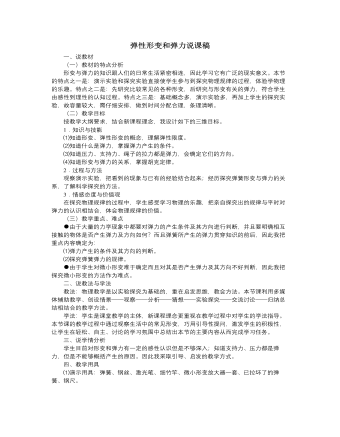
人教版新课标高中物理必修1弹性形变和弹力说课稿
在同一个直角坐标,做出两个不同弹簧的F—X图象,然后进行比较。图象法处理数据更为直观,更容易得出物理变化规律,且该种方法处理数据能更好地减小实验的偶然误差。最后老师归纳总结:得出胡克定律:F=KX(K为弹簧的颈度系数)[设计意图:在探究弹力的大小与形变的定量关系时,由学生进行猜想、实验和得出规律,并利用信息技术计算机绘制F—X图象,充分利用信息技术资源和物理学科的整合。能较好地体现以学生为主的新的教学理念。对探究实验过程教师加以指导,使学生学会团结合作、学会探究物理规律;再加上熟练信息技术,更有效地提高学习效率。](五)弹力的应用(图片,视频播放:射箭)[设计意图:让学生知道产品设计离不开物理理论,做到从实践到理论,再从理论到实践的学习过程。](六)开放式问题(视频播放:撑杆跳高、跳水);提出问题:通过本节内容的学习,请同学们开放式地讨论①从形变与弹力知识去思考,撑杆跳高运动员跳得这么高的主要原因是什么?②跳水运动员在空中滞空时间主要由哪方面决定?
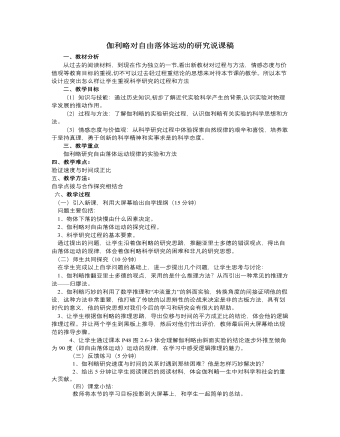
人教版新课标高中物理必修1伽利略对自由落体运动的研究说课稿
(三)反馈练习(5分钟)1、伽利略研究速度与时间的关系时遇到那些困难?他是怎样巧妙解决的?2、给出5分钟让学生阅读课后的阅读材料,体会伽利略一生中对科学和社会的重大贡献。(四)课堂小结:教师将本节的学习目标投影到大屏幕上,和学生一起简单的总结。(五)课后作业1、利用现代的测量仪器设计出一个研究自由落体运动规律的实验,写出需要的器材和实验过程。2、请学生再总结出一些科学研究中常用的思路和方法。通过这两个作业,进一步提高学生的科学研究的意识和素质。本设计所涉及到的科学研究方法:1、归缪法——伽利略用亚里士多德的观点推翻了翻亚里士多德的观点。2、转换法——伽利略用数学推理和斜面实验间接证明他的假设。3、逻辑推理法——用数学方法推理出速度正比于时间则位移与时间二次方成正比。4、外推法——由斜面实验外推至自由落体运动运动规律
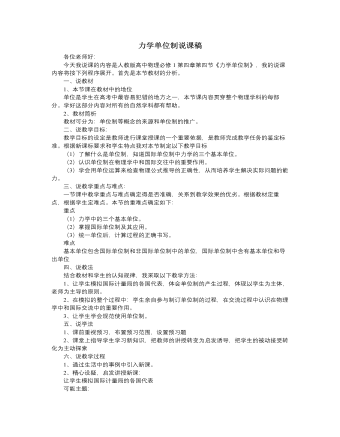
人教版新课标高中物理必修1力学单位制说课稿
今天我说课的内容是人教版高中物理必修1第四章第四节《力学单位制》,我的说课内容将按下列程序展开。首先是本节教材的分析。一、说教材1、本节课在教材中的地位单位是学生在高考中最容易犯错的地方之一,本节课内容贯穿整个物理学科的每部分。学好这部分内容对所有的自然学科都有帮助。2、教材简析教材可分为:单位制等概念的来源和单位制的推广。二、说教学目标:教学目标的设定是教师进行课堂授课的一个重要依据,是教师完成教学任务的鉴定标准。根据新课标要求和学生特点我对本节制定以下教学目标(1)了解什么是单位制,知道国际单位制中力学的三个基本单位。(2)认识单位制在物理学中和国际交往中的重要作用。(3)学会用单位运算来检查物理公式推导的正确性,从而培养学生解决实际问题的能力。
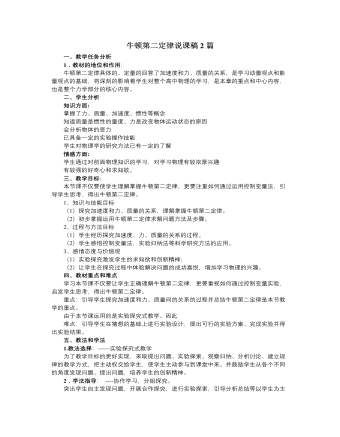
人教版新课标高中物理必修1牛顿第二定律说课稿2篇
进一步引导学生思考利用数学知识可写成等式F=kma学生很自然就会思考比列系数K应该是多少?通过教师引导学生举例各国长度单位不同(如英国:英里、码、英尺、英寸;中国:市里、市丈、市尺、市寸、市分 )导致交流不便。为了适应各国交流需要国际计量局规定了一套统一的单位,称为国际单位制 。取不同的单位制K是不同的,为了简洁方便,在选取了质量和加速度的国际单位(Kg, m/s2)时规定K=1。那么就有;F=ma为了纪念牛顿,就把能使1kg物体获得1m/s2加速度的力称做一牛顿,用符号N表示问题:实际物体受力往往不止一个,多个力情况应该怎么办呢?平行四边形法则进一步引导学生得出牛顿第二定律更一般的表达式: F合=ma思考.讨论我们用力提一个很重的箱子,却提不动它。这个力产生了加速度吗?要是产生了,箱子的运动状态却并没有改变。为什么?
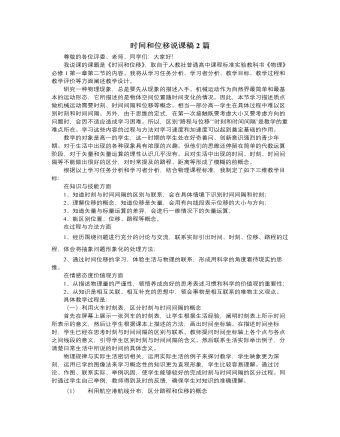
人教版新课标高中物理必修1时间和位移说课稿2篇
研究一种物理现象,总是要先从现象的描述入手。机械运动作为自然界最简单和最基本的运动形态,它所描述的是物体空间位置随时间变化的情况。因此,本节学习描述质点做机械运动需要时刻、时间间隔和位移等概念。相当一部分高一学生在具体过程中难以区别时刻和时间间隔。另外,由于思维的定式,在第一次接触既要考虑大小又要考虑方向的问题时,会因不适应造成学习困难。所以,区别“路程与位移”“时刻和时间间隔”是教学的重难点所在。学习这些内容的过程与方法对学习速度和加速度可以起到奠定基础的作用。教学的对象是高一的学生,这一时期的学生处在好奇善问、创新意识强烈的青少年期。对于生活中出现的各种现象具有浓厚的兴趣。但他们的思维还停留在简单的代数运算阶段,对于矢量和矢量运算的理性认识几乎没有。且对生活中出现的时间、时刻、时间间隔等不能做出很好的区分,对时常提及的路程、距离等形成了模糊的前概念。
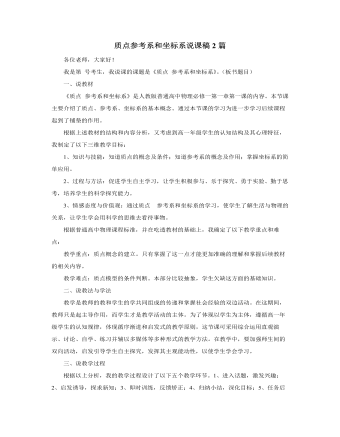
人教版新课标高中物理必修1质点参考系和坐标系说课稿2篇
一、说教材《质点 参考系和坐标系》是人教版普通高中物理必修一第一章第一课的内容。本节课主要介绍了质点、参考系、坐标系的基本概念。通过本节课的学习为进一步学习后续课程起到了铺垫的作用。根据上述教材的结构和内容分析,又考虑到高一年级学生的认知结构及其心理特征,我制定了以下三维教学目标:1、知识与技能:知道质点的概念及条件;知道参考系的概念及作用;掌握坐标系的简单应用。2、过程与方法:促进学生自主学习,让学生积极参与、乐于探究、勇于实验、勤于思考,培养学生的科学探究能力。3、情感态度与价值观:通过质点 参考系和坐标系的学习,使学生了解生活与物理的关系,让学生学会用科学的思维去看待事物。根据普通高中物理课程标准,并在吃透教材的基础上,我确定了以下教学重点和难点:教学重点:质点概念的建立。只有掌握了这一点才能更加准确的理解和掌握后续教材的相关内容。